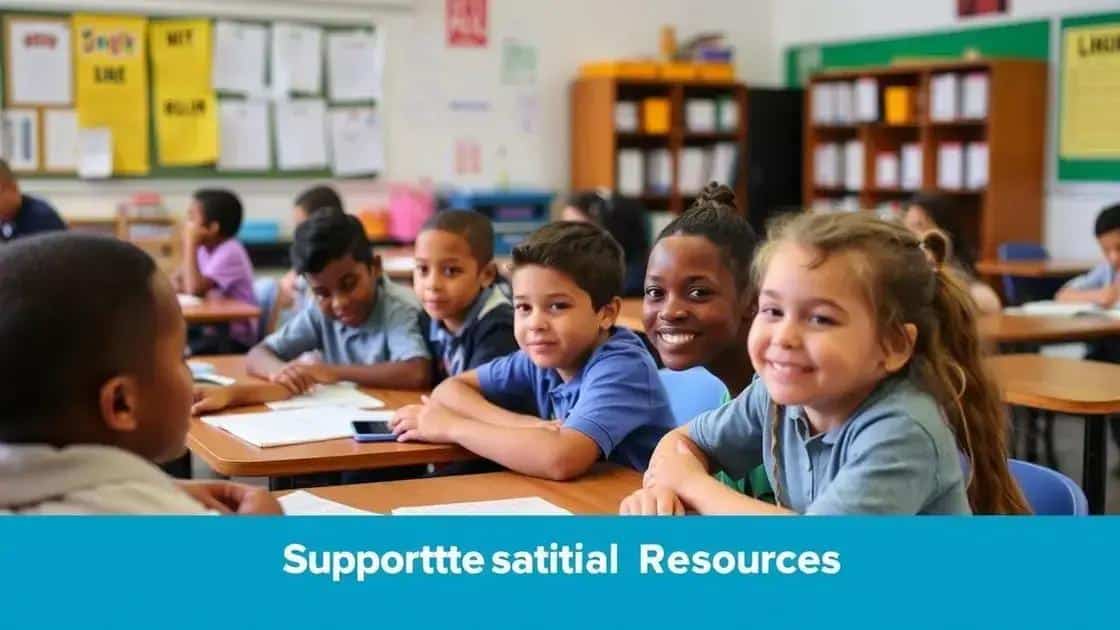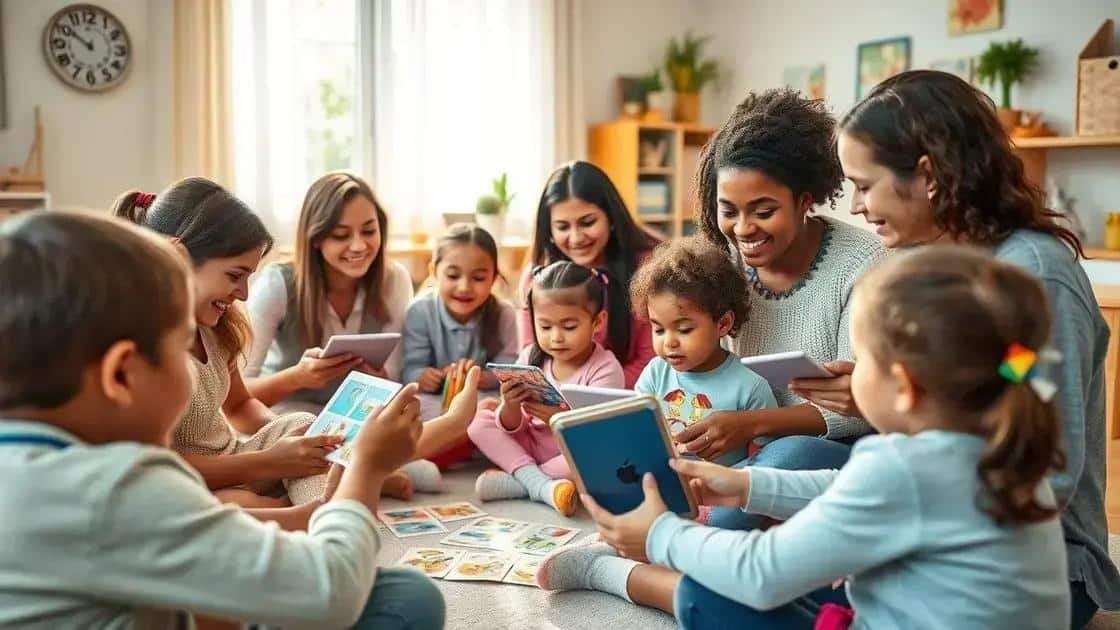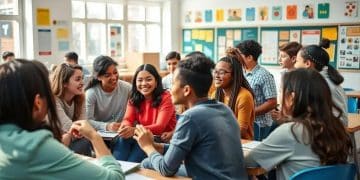Special education resources for every student

Special education resources are critical tools that provide essential support for teachers, parents, and students with diverse needs, enhancing learning outcomes through tailored strategies and collaborative approaches.
Special education resources play a crucial role in supporting students with diverse learning needs. Whether you’re a teacher, parent, or advocate, knowing where to find the right resources can enhance educational outcomes. Let’s dive into the essential tools and strategies available.
Understanding special education needs
Understanding special education needs is essential for creating an inclusive learning environment. It ensures that every student, especially those with disabilities, receives the support necessary for success. Each child is unique, which means their needs may vary widely.
Types of Special Education Needs
There are several categories of special education needs. This can include children with learning disabilities, emotional disturbances, and physical disabilities. By recognizing these categories, educators and parents can tailor their approaches effectively.
- Learning Disabilities: Challenges with reading, writing, or math.
- Behavioral Issues: Difficulties in managing behavior or emotions.
- Physical Disabilities: Impairments that may affect mobility or communication.
Every child deserves the right tools to thrive. It is vital to understand that some children may require specific accommodations. Examples include extra time on tests or modified assignments.
Identifying Special Needs
To identify special education needs, teachers often utilize assessments and observations. Early intervention is key. By recognizing signs early, timely help can be provided. Parents play a crucial role in this process. They can share insights about their child’s behavior and development.
Regular communication between parents and educators fosters a better understanding of special education needs. Collaboration ensures that everyone is on the same page, ultimately benefiting the child.
Using a multidisciplinary approach, such as involving speech therapists or counselors, can provide comprehensive support. This teamwork helps to create a structured plan tailored to the child’s needs, promoting their academic and social development.
Key resources for teachers
Teachers play a vital role in supporting students with special education needs. Knowing where to find the right resources can make all the difference in their teaching effectiveness.
Online Training Programs
There are many online training programs available that focus on special education. These programs help teachers understand the various needs of their students and equip them with effective strategies.
- Webinars on inclusive teaching.
- Courses on behavior management.
- Workshops about adaptive technologies.
By participating in these programs, teachers can learn best practices and methods that can be applied in their classrooms.
Educational Tools and Software
Utilizing educational tools can enhance learning for students with special needs. Resources such as visual aids, apps, and assistive technologies can greatly benefit teachers.
- Interactive learning platforms.
- Reading and writing assistance software.
- Math learning tools tailored for diverse learners.
These tools not only assist students but also provide teachers with innovative ways to engage them in the curriculum. It’s important for educators to stay updated on the latest technologies.
Collaboration with special education professionals is also beneficial. Teachers can gain insights into specific strategies and interventions tailored to individual student needs. This partnership allows for a more comprehensive support system.
Sharing experiences with fellow teachers can further enrich teaching methods. Building a community of educators focused on special education resources ensures a collective approach towards addressing challenges and celebrating successes.
Tools for parents and caregivers

Parents and caregivers play a crucial role in supporting children with special education needs. Utilizing the right tools can empower them to provide effective assistance and advocacy.
Communication Aids
Tools that enhance communication are vital. These aids help parents connect with their children and understand their needs better. Choices include:
- Communication boards to help non-verbal children express themselves.
- Apps designed for speech therapy.
- Picture exchange systems for daily routines.
By using these aids, parents can enhance interactions and facilitate learning at home.
Educational Resources
Accessing educational materials tailored to special education can greatly support learning. There are numerous resources available for parents, including:
- Educational kits that focus on skill-building.
- Online platforms offering lessons and tutorials.
- Books and guides on special education strategies.
These resources enable parents to create structured learning environments that cater to their child’s unique needs.
Furthermore, joining support groups can be beneficial for parents. These groups offer a platform to share experiences, exchange advice, and find encouragement. Connecting with others who understand similar challenges creates a sense of community and reduces feelings of isolation.
Awareness of local services is also crucial. Many communities provide specialized programs for children with special education needs. By researching and utilizing these services, parents can maximize the support available for their children.
Collaborating with specialists
Collaborating with specialists is essential for addressing the diverse needs of students with special education needs. This teamwork helps create a supportive learning environment.
Identifying Specialists
There are various types of specialists that can provide valuable insights. These may include:
- Speech therapists for communication disorders.
- Occupational therapists to assist with daily living skills.
- Behavioral specialists who focus on managing challenging behaviors.
Finding the right professional depends on the child’s specific needs. Each specialist offers unique strategies that can enhance a child’s learning experience.
Benefits of Collaboration
When teachers collaborate with specialists, they can develop a more comprehensive understanding of each student’s strengths and challenges. This partnership allows for tailored interventions. Specialists may conduct assessments to identify specific areas where students need support. Teachers can implement these strategies within the classroom.
Frequent communication between teachers and specialists also ensures everyone is on the same page. Regular meetings and updates foster an environment of shared goals. This teamwork can lead to successful outcomes for students with special education needs.
Engaging with parents in this process is equally important. By including families in discussions, all parties can contribute insights. This unified approach strengthens the support network around each child and encourages better academic progression.
Finally, professional development opportunities often arise from such collaborations. Educators can learn new techniques and strategies from specialists, enhancing their skill sets and improving their effectiveness in the classroom.
Success stories from educational settings
Success stories from educational settings highlight the positive impact of effective strategies for students with special education needs. These stories inspire and demonstrate what is possible when proper support is in place.
Aspiring Athletes in the Classroom
One remarkable example involved a student named Jordan, who struggled with dyslexia. With tailored reading interventions and assistive technology, Jordan began to thrive. Teachers noticed a shift in confidence as he read aloud in class.
- Participants in specialized reading programs.
- Use of audiobooks to enhance comprehension.
- Regular progress monitoring to adjust strategies.
As a result, Jordan not only improved his reading skills but also became an advocate for others facing similar challenges.
Collaboration Leading to Growth
Another inspiring story comes from a school that implemented collaborative teaching. The special education teacher worked closely with general education teachers to support students with varying needs. This involved creating lesson plans that involved both teaching styles, making learning more inclusive.
Students benefited tremendously from this approach. They felt more engaged and supported. Here are some examples of positive outcomes:
- Increased student participation.
- Higher test scores across the board.
- Enhanced peer relationships.
Such cooperation not only supports students but also enriches the teaching experience. Teachers share insights and strategies, creating a culture of learning that stretches beyond the classroom.
Ultimately, these success stories highlight the broad spectrum of possibilities. When educators and specialists collaborate effectively, they can make significant strides in supporting students with special education needs. More importantly, they create an environment where every student feels valued and capable of success.
FAQ – Frequently Asked Questions about Special Education Resources
What are some effective tools for supporting students with special education needs?
Tools such as communication aids, educational apps, and specialized learning resources can provide critical support tailored to individual needs.
How can parents and teachers collaboratively help children with special needs?
By maintaining open communication, sharing insights, and working together on intervention strategies, parents and teachers can create a more effective support system.
What role do specialists play in special education?
Specialists, such as speech therapists and behavioral specialists, offer expertise and tailored strategies to address specific challenges faced by students.
How can success stories impact students and educators in special education?
Success stories inspire students and educators, demonstrating the potential for positive outcomes when effective strategies and collaboration are in place.






